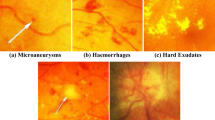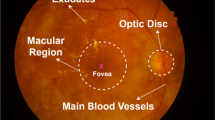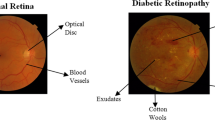Abstract
The diabetic retinopathy accounts in the deterioration of retinal blood vessels leading to a serious compilation affecting the eyes. The automated DR diagnosis frameworks are critically important for the early identification and detection of these eye-related problems, helping the ophthalmic experts in providing the second opinion for effectual treatment. The deep learning techniques have evolved as an improvement over the conventional approaches, which are dependent on the handcrafted feature extraction. To address the issue of proficient DR discrimination, the authors have proposed a quadrant ensemble automated DR grading approach by implementing InceptionResnet-V2 deep neural network framework. The presented model incorporates histogram equalization, optical disc localization, and quadrant cropping along with the data augmentation step for improving the network performance. A superior accuracy performance of 93.33% is observed for the proposed framework, and a significant reduction of 0.325 is noticed in the cross-entropy loss function for MESSIDOR benchmark dataset; however, its validation utilizing the latest IDRiD dataset establishes its generalization ability. The accuracy improvement of 13.58% is observed when the proposed QEIRV-2 model is compared with the classical Inception-V3 CNN model. To justify the viability of the proposed framework, its performance is compared with the existing state-of-the-art approaches and 25.23% of accuracy improvement is observed.






Similar content being viewed by others
References
Fong DS, Aiello L, Gardner TW, King GL, Blankenship G, Cavallerano JD, Ferris FL, Klein R, "Retinopathy in diabetes." Diabetes care 27, 1:s84-s87,2004.
Yen GG, Leong WF, "A sorting system for hierarchical grading of diabetic fundus images: A preliminary study." IEEE Trans Inf Technol Biomed 12, 1:118-130,2008.
Xiao D, Bhuiyan A, Frost S, Vignarajan J, Tay-Kearney ML, Kanagasingam Y, "Major automatic diabetic retinopathy screening systems and related core algorithms: a review. " Mach Vis Appl 30, 3:423-446,2019.
Kandel I, and Castelli M, "Transfer Learning with Convolutional Neural Networks for Diabetic Retinopathy Image Classification. A Review. " Appl Sci 10:6,2020.
Deng J, Dong W, Socher R, Li LJ, Li K, and Fei-Fei L, "ImageNet: A large-scale hierarchical image database. " in IEEE Conference on Computer Vision and Pattern Recognition, 248–255,2009.
Somasundaram SK, and Alli P, "A machine learning ensemble classifier for early prediction of diabetic retinopathy." J Med Syst 41,12:201,2017.
Srivastava R, Duan L, Wong DWK, Liu J, and Wong TY, Detecting retinal microaneurysms and hemorrhages with robustness to the presence of blood vessels. Comput Methods Prog Biomed 138:83–91,2017.
Seoud L, Chelbi J, and Cheriet F, Automatic grading of diabetic retinopathy on a public database. 2015.
Sankar M, Batri K, and Parvathi R, "Earliest diabetic retinopathy classification using deep convolution neural networks. pdf." Int J Adv Eng Technol, 2016.
Seoud L, Hurtut T, Chelbi J, Cheriet F, and Langlois JP, Red lesion detection using dynamic shape features for diabetic retinopathy screening. IEEE Trans Med Imaging 35, 4:1116–1126,2015.
Pires R, Jelinek HF, Wainer J, Goldenstein S, Valle E, and Rocha A, "Assessing the need for referral in automatic diabetic retinopathy detection." IEEE Trans Biomed Eng 60, 12:3391-3398,2013.
Antal B, and Hajdu A, "An ensemble-based system for microaneurysm detection and diabetic retinopathy grading." IEEE Trans Biomed Eng 59, 6:1720,2012.
Mansour RF, Evolutionary Computing Enriched Computer-Aided Diagnosis System for Diabetic Retinopathy: A Survey. IEEE Rev Biomed Eng 10:334–349,2017.
Dai L, Fang R, Li H, Hou X, Sheng B, Wu Q, and Jia W, "Clinical Report Guided Retinal Microaneurysm Detection With Multi-Sieving Deep Learning." IEEE Trans Med Imaging 37, 5:1149-1161,2018.
Rahim SS, Jayne C, Palade V, and Shuttleworth J. Automatic detection of microaneurysms in colour fundus images for diabetic retinopathy screening. Neural Comput Applic 27, 5:1149–1164,2016.
Mohammed ZF, and Abdulla AA. Thresholding-based White Blood Cells Segmentation from Microscopic Blood Images. UHD J Sci Tech 4, 1:9–17,2020.
Abbas Q, Fondon I, Sarmiento A, Jiménez S, and Alemany P, "Automatic recognition of severity level for diagnosis of diabetic retinopathy using deep visual features." Med Biol Eng Comput 55, 11:1959-1974,2017.
Wang Z, and Yang J, Diabetic retinopathy detection via deep convolutional networks for discriminative localization and visual explanation. arXiv preprint arXiv 1703.10757, 2017.
Yu FL, Sun J, Li A, Cheng J, Wan C, and Liu J, Image quality classification for DR screening using deep learning. In 2017 39th Conf Proc IEEE Eng Med Biol Soc (EMBC), 664–667. IEEE, 2017.
Gao Z, Li J, Guo J, Chen Y, Yi Z, and Zhong J, "Diagnosis of Diabetic Retinopathy Using Deep Neural Networks." IEEE Access 7:3360-3370,2018.
Mateen M, Wen J, Song S, and Huang Z, "Fundus Image Classification Using VGG-19 Architecture with PCA and SVD." Symmetry 11, 1:1,2019.
Li X, Pang T, Xiong B, Liu W, Liang P, and Wang T, Convolutional neural networks based transfer learning for diabetic retinopathy fundus image classification. In 2017 10th International Congress on Image and Signal Processing, BioMedical Engineering and Informatics (CISP-BMEI), 1–11. IEEE, 2017.
Lam C, Yi D, Guo M, and Lindsey T, Automated detection of diabetic retinopathy using deep learning. AMIA Summits on Translational Science Proceedings 147, 2018.
Perdomo O, Otalora S, Rodr´ıguez F, Arevalo J, and Gonz´alez FA, A novel machine learning model based on exudate localization to detect diabetic macular edema, 2016.
Hazim JM, et al: "Early Detection of Diabetic Retinopathy by Using Deep Learning Neural Network", International Journal of Engineering & Technology 7, 411:1997- 2004,2018.
Wang Z, Yin Y, Shi J, Fang W, Li H, and Wang X, Zoom-in-net: Deep mining lesions for diabetic retinopathy detection. In International Conference on Medical Image Computing and Computer-Assisted Intervention, 267–275. Springer, Cham, 2017.
Chen YW, Wu TY, Wong WH, Lee CY, Diabetic retinopathy detection based on deep convolutional neural networks. In 2018 IEEE International Conference on Acoustics, Speech and Signal Processing (ICASSP). 1030–1034,2018.
Gonçalves J, Conceiçao T, Soares F, Inter-observer Reliability in Computer-aided Diagnosis of Diabetic Retinopathy. In HEALTHINF. 481–491,2019.
Li X, Hu X, Yu L, Zhu L, Fu CW, Heng PA, "CANet: Cross-Disease Attention Network for Joint Diabetic Retinopathy and Diabetic Macular Edema Grading. " IEEE Trans Med Imaging 39. 5:1483-93,2019.
Saranya P, Prabakaran S, Automatic detection of non-proliferative diabetic retinopathy in retinal fundus images using convolution neural network. J Ambient Intell Humaniz Comput, 2020.
Staal J, Abràmoff MD, Niemeijer M, Viergever MA, and Van Ginneken B, Ridge-based vessel segmentation in color images of the retina. IEEE Trans Med Imaging 23, 4:501–509,2004.
Hoover AD, Kouznetsova V, and Goldbaum M, Locating blood vessels in retinal images by piecewise threshold probing of a matched filter response. IEEE Trans Med Imaging 19, 3:203–210,2000.
Kauppi T, Kalesnykiene V, Kamarainen JK, Lensu L, Sorri I, Raninen A, Voutilainen R, Uusitalo H, Kälviäinen H, and Pietilä J, "The diaretdb1 diabetic retinopathy database and evaluation protocol." In BMVC 1:1-10,2007.
Niemeijer M, Van Ginneken B, Cree MJ, Mizutani A, Quellec G, Sánchez CI, Zhang B, et al: Retinopathy online challenge: automatic detection of microaneurysms in digital color fundus photographs. IEEE Trans Med Imaging 29, 1:185–195,2009.
Decencière E, Zhang X, Cazuguel G, Lay B, Cochener B, Trone C, and Charton B. "Feedback on a publicly distributed image database: the Messidor database. " Image Analysis & Stereology 33, 3:231-234,2014.
Porwal P, Pachade S, Kamble R, Kokare M, Deshmukh G, Sahasrabuddhe V, and Meriaudeau F, Indian diabetic retinopathy image dataset (IDRiD): a database for diabetic retinopathy screening research. Data 3, 3:25,2018.
Bhardwaj C, Jain S, and Sood M, Appraisal of Pre-processing Techniques for Automated Detection of Diabetic Retinopathy. In 2018 Fifth International Conference on Parallel, Distributed and Grid Computing (PDGC), 734–739. IEEE,2018.
Janney BJ, Divakaran S, Abraham S, Uma SG, Meera G, Shankar G, Detection and classification of exudates in retinal image using image processing techniques. J Chem Pharm Sci 8(3):541–546. 2015.
Akyol K, Şen B, and Bayır Ş, Automatic detection of optic disc in retinal image by using keypoint detection, texture analysis, and visual dictionary techniques. Comput Math Methods Med 2016, 2016.
Bhardwaj C, Jain S, Sood M, Automated Optical Disc Segmentation and Blood Vessel Extraction for Fundus Images Using Ophthalmic Image Processing, In International Conference on Advanced Informatics for Computing Research, 182–194. Springer, Singapore, 2018.
Bajwa MN, Malik MI, Siddiqui SA, Dengel A, Shafait F, Neumeier W, Ahmed Sheraz, Two-stage framework for optic disc localization and glaucoma classification in retinal fundus images using deep learning, BMC Med Inform Decis. Mak 19, 1:136, 2019.
LeCun Y, Boser BE, Denker JS, Henderson D, Howard RE, Hubbard WE, Jackel LD, Handwritten digit recognition with a back-propagation network. In Advances in neural information processing systems, 396–404. 1990.
Xu K, Feng D, Mi H, "Deep convolutional neural network-based early automated detection of diabetic retinopathy using fundus image," Molecules 22, 12:2054,2017.
Mohammadian S, Karsaz A, Roshan YM, 2017, November. Comparative Study of Fine-Tuning of Pre-Trained Convolutional Neural Networks for Diabetic Retinopathy Screening, In 2017 24th National and 2nd International Iranian Conference on Biomedical Engineering (ICBME), 1–6, IEEE, 2017.
LeCun Y, Bottou L, Bengio Y, Haffner P, "Gradient-based learning applied to document recognition." Proc IEEE 86, 11:2278-2324,1998.
Krizhevsky A, Sutskever I, Hinton GE, Imagenet classification with deep convolutional neural networks. In Adv Neural Inf Proces. Syst, 1097–1105,2012.
Simonyan K, Zisserman A, Very deep convolutional networks for large-scale image recognition. arXiv preprint arXiv 1409.1556, 2014.
He K, Zhang X, Ren S, Sun J, Deep residual learning for image recognition. In Proc IEEE Conf Comput Vis Pattern Recognit, 770–778,2016.
Szegedy C, Ioffe S, Vanhoucke V, Alemi A, Inception-v4, inception-resnet and the impact of residual connections on learning. arXiv preprint arXiv 1602.07261, 2016.
Author information
Authors and Affiliations
Corresponding author
Ethics declarations
Ethical Approval
This article does not contain any studies with human participants or animals performed by any of the authors.
Conflict of Interest
The authors declare that they have no conflict of interest.
Additional information
Publisher’s Note
Springer Nature remains neutral with regard to jurisdictional claims in published maps and institutional affiliations.
Rights and permissions
About this article
Cite this article
Bhardwaj, C., Jain, S. & Sood, M. Deep Learning–Based Diabetic Retinopathy Severity Grading System Employing Quadrant Ensemble Model. J Digit Imaging 34, 440–457 (2021). https://doi.org/10.1007/s10278-021-00418-5
Received:
Revised:
Accepted:
Published:
Issue Date:
DOI: https://doi.org/10.1007/s10278-021-00418-5




